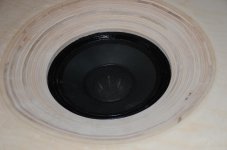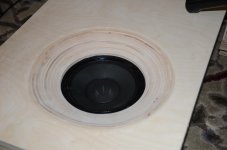I wonder why more people don't just stick a coaxial on a waveguide?
You get the directivity of an 18" waveguide, with the midrange response of an 8" woofer.
[/QUOTE]
Exactly what I'm doing with some JBL 328CTs, I have 1.5" of baffle thickness depth to use to extend the 120 degree cone profile, which should get me out to the 14"" range when including a substantial mouth flare. The first step is determining how much thickness to leave at the flare entry to match the cone profile, 1/4" looks right (and may be a practical minimum for any reasonable mounting strength). I'll be using a coping saw to cut the flares, which will take some serious work, but I can define the endpoints of the cut with a shallow circle routed onto the face for the outer diameter and a thickness of the BB ply on the driver end of the cut.
I've done the work cutting the 120 degree waveguide into the baffle with the exception of the mouth flare and some more sanding time, but I'm wondering if I should flare the mouth at all- or leave it for if/when I want to extend the profile even further (and use a felt ring to terminate the flare in the meantime).
...Other than the Westrern Electric 4181a and the BTH K-10A 18" Coaxial Drivers, were there ever any other 18" Coaxial units made?
What UK available alternatives could I consider? I propose a system using around a 8-10 Cu Ft enclosure
McCauley used to do a modular coaxial system that had an 18" option.
Now marked "discontinued" but some of the components are still listed on their website so they may have stock still to clear.
Or at least you can search on Ebay, it's not a brand many people think of.
Best wishes
David
An externally hosted image should be here but it was not working when we last tested it.
Still plugging away. Crossovers are mounted, with rubber grommets for standoffs. For the drivers I used the ply rings and threaded inserts into the baffle with 10/24 bolts and washers. This layout let me get a good amount of mounting strength, centering, without having to try to fasten into the thin wood near the "mouth" of the baffle waveguide. I still had to be careful not to break the wall of the waveguide, as the fasteners are about halfway along the profile.
McCauley used to do a modular coaxial system that had an 18" option.
Now marked "discontinued" but some of the components are still listed on their website so they may have stock still to clear.
Or at least you can search on Ebay, it's not a brand many people think of.
Best wishes
David
Many thanks for the pointer
RSL Europe Audio and Light still have a couple of 15" P Audio "Blue Monster" drivers on their price list. Either NOS, or an out of date list.
(1) BM-15CXHB for 194 Euro. I have a pair of these, and like them. They look like an Altec copy, but seem to have been designed for less bass / more efficiency. I got them because they looked easy to work with, and they are - they don't require a difficult crossover.
(2) BM-15CX38 for 240 Euro. This one didn't look as good to me, but the 'common sense audio' site used to stock them "WE USED TO SELL A GREAT PAUDIO SPEAKER CALLED THE BM-CX38 SERIES. THIS WAS A VERY HIGH QUALITY, VERY EFFICIENT, HIGH FIDELITY COAXIAL LOUDSPEAKER. HOWEVER, THESE ARE NOW DISCONTINUED."
(1) BM-15CXHB for 194 Euro. I have a pair of these, and like them. They look like an Altec copy, but seem to have been designed for less bass / more efficiency. I got them because they looked easy to work with, and they are - they don't require a difficult crossover.
(2) BM-15CX38 for 240 Euro. This one didn't look as good to me, but the 'common sense audio' site used to stock them "WE USED TO SELL A GREAT PAUDIO SPEAKER CALLED THE BM-CX38 SERIES. THIS WAS A VERY HIGH QUALITY, VERY EFFICIENT, HIGH FIDELITY COAXIAL LOUDSPEAKER. HOWEVER, THESE ARE NOW DISCONTINUED."
Have got BM15CX38. Fantastic driver, although limited low frequency extension in any sane size of box. 15" cone J U S T manages to get up to a reasonable x-over frequency to the 2" tweeter (which can actually go pretty low in a modestly powered system, if you don't mind crossovers in the middle of the speech band...).
Have got BM15CX38. Fantastic driver, although limited low frequency extension in any sane size of box. 15" cone J U S T manages to get up to a reasonable x-over frequency to the 2" tweeter (which can actually go pretty low in a modestly powered system, if you don't mind crossovers in the middle of the speech band...).
Is it what you do most of your listening with? Where did you set the crossover?
Years ago, looking at this spec sheet, both of these 15s looked like they had loads of overlap between the cones and HF drivers. I picked the HB because it had flatter response, as far as could be seen on their heavily smoothed graph, so I thought it's be easier to work with / build a crossover for. Plus I like that it looks like a coaxial
http://www.paudio.ro/pdf/products/BM-15CXHB.pdf
This other spec sheet for the CX38 has a FR plot that's unsmoothed and looks rather good, both drivers well behaved for the octave around 1.5kHz.
http://www.samodelka.ru/pictures/paudio/1410062.pdf
Note how wildly the specs varied - different VAS, Fs and a 6dB change in efficiency between the two sheets. Their product consistency is pretty poor.
No, I used them as mains for a while but they were visually overwhelming in the lounge room.Is it what you do most of your listening with? Where did you set the crossover?
snip
Now they are the 'kick-****' second monitors in my home studio. Mix on the nearfields and then cross check it by cranking the P-Audios. Oh, Mama.....
The apparent overlap is a bit deceptive because the 15" cone dispersion has narrowed to buggery by the time you're up and over the voice range.
As I am only feeding mine with 50W chip amps and a MiniDSP I have cheated a bit and use a 3rd order on the bottom at a notional 2k and a first order at about 3k on the tweeter, with a heap of EQ to cut it away below 1k. Works OK, sounds OK, measures OK but I hate crossovers in the voice range.
The two best coaxial drivers ever made still have the biggest following Tannoy & Altec and for good reason they both sound great I have only listened to one other coaxial i liked and that was a Radian i have heard their 12" 5212 and it sounds great clean clear high frequency extension out to 18K without break up it's using the 475pb driver on a 12" cone the ones i listened to were in a cabinet with JBL 15" using a active crossover and bi amped and they were very impressive.
hi darkmatter, did you get any 18" coax? impressions? can you post pics?
darkmatter, did you get McCauley? Did you built anything? Pics?
I've made a similar experiment with a 15" coaxial with 2" CD. The HF crossover was around 1.5kHz and could not be raised (or the woofer would break up), could not be lowered or the HF would audibly distort.
The result (in a DTQWT enclosure the size of a dorm room refrigerator) was quite good at frequency extremes, but unlistenable for vocals.
It always felt as if the lead singer was complaining about their soup, or the violins were auditioning for a Horror movie soundtrack.
FWIW - crossover below 1kHz (larger HF horn required) or above 2.5kHz (with a smaller woofer).
http://www.troelsgravesen.dk/Beaming.htm
Sent from my Nexus 6 using Tapatalk
The result (in a DTQWT enclosure the size of a dorm room refrigerator) was quite good at frequency extremes, but unlistenable for vocals.
It always felt as if the lead singer was complaining about their soup, or the violins were auditioning for a Horror movie soundtrack.
FWIW - crossover below 1kHz (larger HF horn required) or above 2.5kHz (with a smaller woofer).
http://www.troelsgravesen.dk/Beaming.htm
Sent from my Nexus 6 using Tapatalk
darkmatter, did you get McCauley? Did you built anything? Pics?
Hi, I never pursued this any further as I couldn't find a suitable driver
The 18" McCauley is no longer made, there is an 18" coaxial the BTH K-10A 18" Coaxial Driver, but they are rarer than Hen's teeth, way out of my budget

- Status
- This old topic is closed. If you want to reopen this topic, contact a moderator using the "Report Post" button.
- Home
- Loudspeakers
- Multi-Way
- 15" Or Larger 2 way coaxial drivers were there any 18" Coaxials made?



